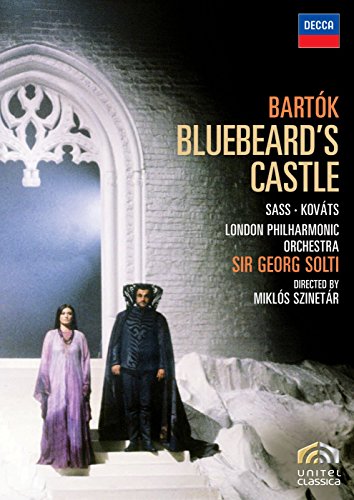Bartók: Bluebeard’s Castle
Sir Georg Solti, the great Hungarian maestro, conducts Bartok’s only opera with an all-Hungarian cast. This film version also features the London Philharmonic Orchestra and celebrated soprano Sylvia Sass as Judith.Béla Bartók’s sole opera, Bluebeard’s Castle, is a masterpiece well-served by an all-Hungarian cast and conductor in this filmed studio version. It’s a dark, brooding work peppered with dramatic moments; less a retelling of the Bluebeard legend than a journey into psychological depths and the impenetrability of the human soul. Bluebeard and his bride, Judith, arrive at his castle and as they enter the subterranean fortress whose walls sigh with tears, she notices seven locked doors and insists that Bluebeard give her the keys to unlock them. Reluctantly, he agrees. She opens the doors, one by one, to reveal a torture chamber, an armory, a room of treasures, a secret garden, his vast domains, a lake of tears, and, behind the seventh door, his former wives, frozen in immobility, whom she joins, consigned by Bluebeard to his past and his frozen soul. “All is darkness,” he says, and the orchestra fades away in Stygian gloom. The third character in the opera is the orchestra, commenting upon and describing the scenes in Debussy-influenced colors and imaginative scoring. The orchestral sighs, its stabbing figures delineate the “blood motif” that runs through the work, and when Judith opens the fifth door that reveals the glories of Bluebeard’s kingdom, its radiant climax is one of modern opera’s most thrilling moments. Sir Georg Solti was a great Bartók conductor and his dynamic, idiomatic reading is a major asset of this production. His singers are excellent too. Sylvia Sass acts well as Judith, wheedling and imperiously demanding at turns, and if her top notes are shrill at times, her rich lower register more than compensates. She’s costumed in a flowing mauve nightgown fringed in a darker purple, giving the impression of a bird in flight when she moves. Bass Kolos Kováts is a commanding Bluebeard, deep of voice, noble in demeanor, though somewhat stolid as an actor. He’s costumed in an outfit more fitting for a B movie about alien planets, with a campy black leather outfit, a high collar framing his head.
Set designer Gábor Bachmann’s gloomy castle is well portrayed. He lets us enter each of the secret rooms with variable results; the shining treasury and the garden come off well, the vast kingdom is anything but vast or even impressive. Director Miklós Szinetár does what he can to introduce movement to an inherently static opera, and having Sass portray all three of Bluebeard’s former wives in the final scene is a neat touch. The prerecorded sound mix favors the singers to the detriment of orchestral detail, though enough shines through to leave us in awe at both Bartók’s genius and Solti’s mastery. —Dan Davis
Bluebeard’s Castle, is in 4:3 ratio. Sound options include PCM Stereo and DTS 5.1 Surround. Sung in Hungarian with subtitles in English, French, German, Spanish, and Chinese. No extras are included.













